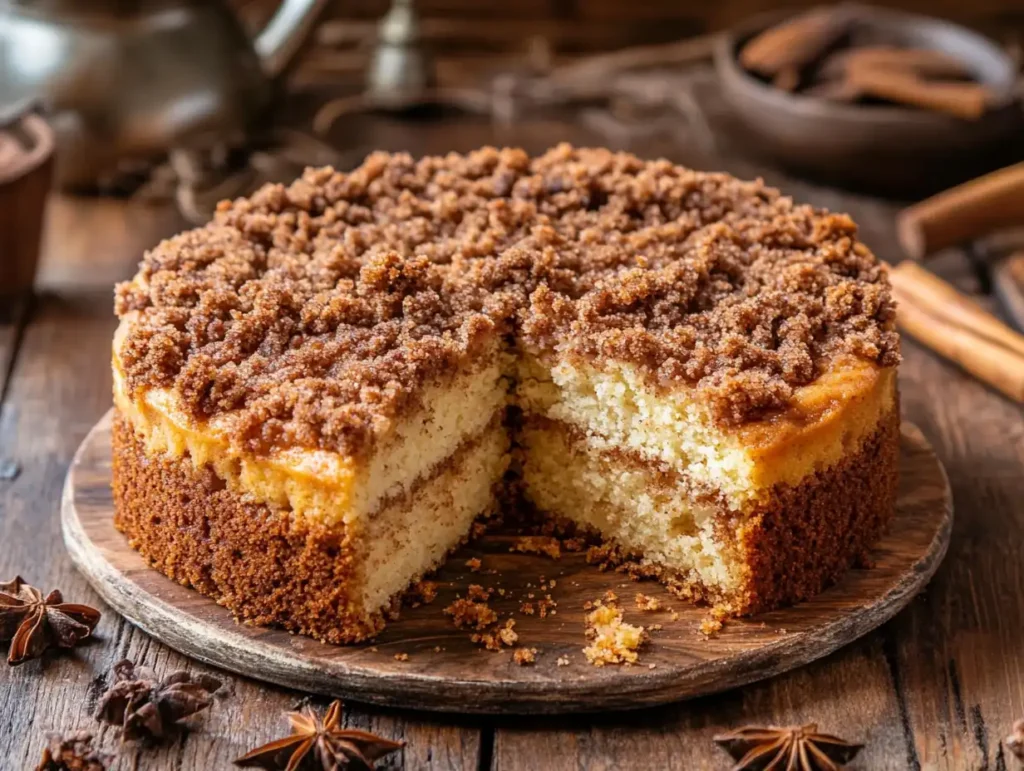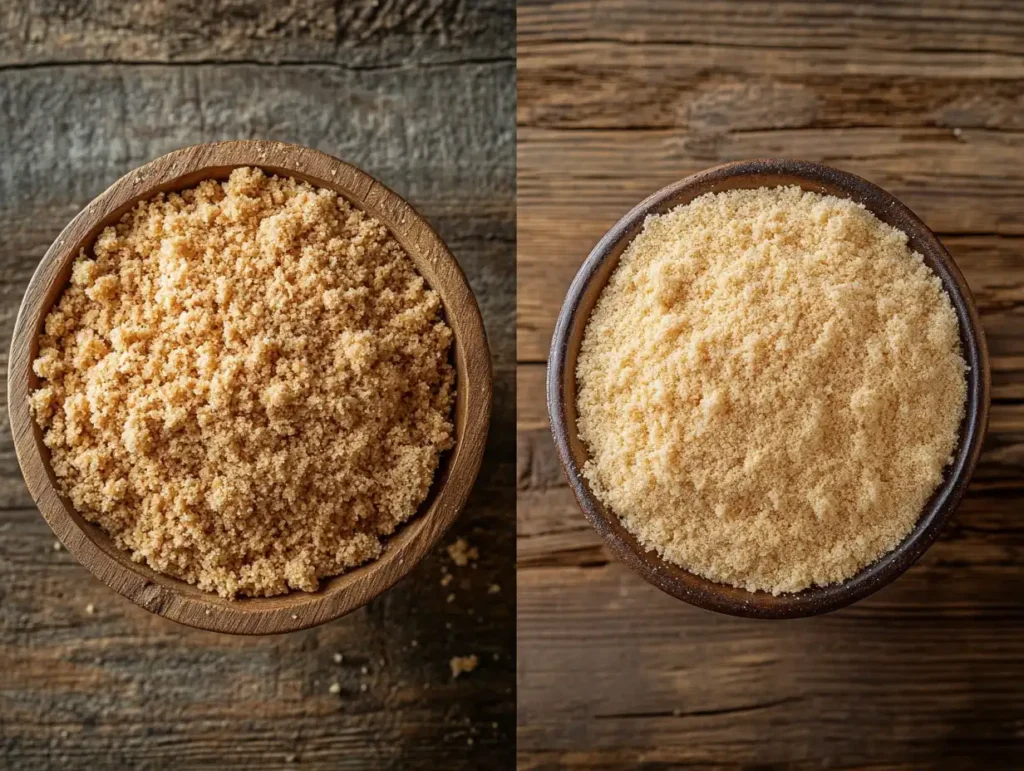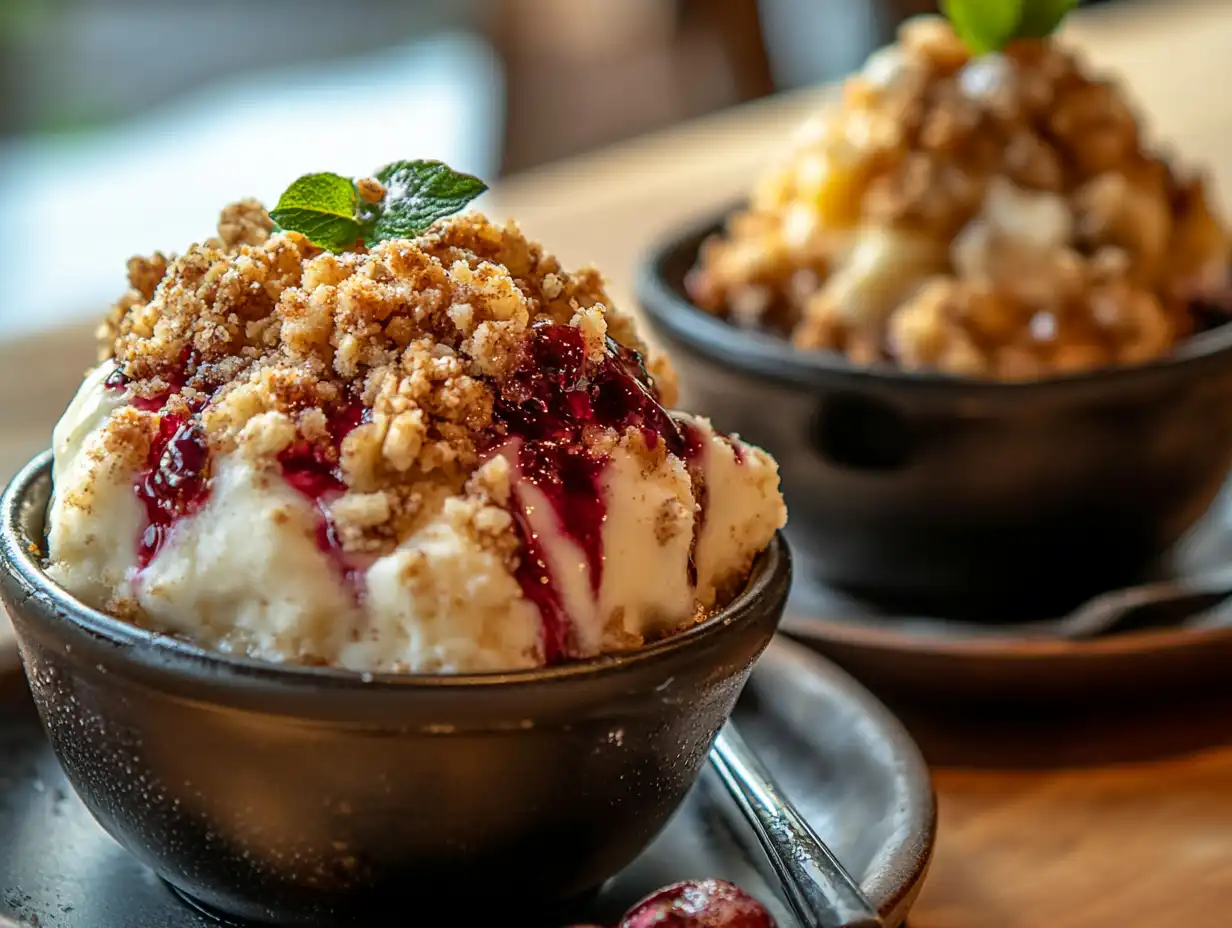whats the difference between crumble and streusel ? Both are beloved toppings in the culinary world, adding delightful texture and flavor to a variety of dishes, but their differences are often misunderstood. Are they the same? Do they serve different purposes? Knowing the difference can elevate your baking game and help you choose the right topping for your next dessert masterpiece.
In this article, we will explore the distinct characteristics of crumble and streusel, diving into their definitions, origins, and uses. From their unique ingredients and preparation methods to their culinary applications, this guide will help you understand why each has its place in the baking repertoire. Whether you’re planning to bake a fruit pie or a muffin, you’ll know exactly when to reach for crumble or streusel or how to experiment with both!
Table of Contents
What is Crumble?
Definition and Origins
Crumble refers to a classic dessert topping, primarily used in British cuisine, that adds a delightful, coarse texture to baked dishes. Originating in England during World War II, crumble was developed as a more economical alternative to traditional pies, which required large amounts of butter and flour for the crust. Bakers found that a simple mixture of flour, butter, and sugar could be scattered over fruit fillings to create a crispy, golden topping.
Over the years, crumble has evolved beyond its wartime roots and is now a staple in kitchens worldwide, particularly in regions that celebrate fruit-based desserts.
Common Uses of Crumble in Recipes
Crumble is most commonly used as a topping for fruit-based desserts. Classic examples include apple crumble, rhubarb crumble, and berry crumble, where the sugary topping contrasts beautifully with the tartness of the fruit. For instance, check out this Peach Crumble Recipe – A Delightful Dessert for All Occasions to see how crumble can transform a dish.
Ingredients of a Traditional Crumble
A traditional crumble topping consists of just three main ingredients:
- Flour: Acts as the base of the crumble and gives it structure.
- Butter: Provides richness and helps achieve a crumbly texture.
- Sugar: Sweetens the topping and aids in caramelization during baking.
Optional additions, such as oats, nuts, or spices like cinnamon and nutmeg, can be incorporated to add flavor and texture.
Variations of Crumble Across Cuisines
While the classic British crumble remains the most recognized, variations have emerged globally. For example, in the U.S., crumble often includes oats, making it heartier and more textured. Curious about the nuances? See What is the Difference Between a Peach Crumble and a Peach Crisp? for a detailed comparison.
Crumble has become a versatile component of baking, cherished for its simplicity and adaptability.
What is Streusel?

Definition and Origins
Streusel, a term derived from the German word meaning “to scatter” or “to sprinkle,” is a crumbly topping used primarily in German and Central European baking. First appearing in the 19th century, streusel was traditionally used to enhance the flavor and texture of baked goods like cakes and pastries. Unlike crumble, which is more closely associated with fruit-based desserts, streusel is often a star topping for coffee cakes, muffins, and breads.
The hallmark of streusel lies in its finer texture and rich, buttery flavor, which makes it a beloved addition to both sweet and savory dishes.
Common Uses of Streusel in Recipes
Crumble is also cherished for its adaptability. In savory dishes, it’s sometimes used for vegetable gratins or pot pies. For fruit-based desserts, the choice of preparation can make a difference discover tips like What Happens If You Don’t Peel Peaches for Cobbler? for inspiration.
- Coffee cakes: The topping adds a sweet, crumbly layer that pairs perfectly with the cake’s soft texture.
- Muffins: Streusel enhances the flavor and appearance of muffins, offering a delightful crunch with each bite.
- Pastries and pies: In some variations, streusel is used as an alternative to pie crust or to top pastries like danishes.
Unlike crumble, streusel is rarely used in savory dishes, as its primary role is to provide sweetness and textural contrast.
Ingredients of a Traditional Streusel
Traditional streusel includes the following key ingredients:
- Flour: Acts as the structural base.
- Butter: Provides richness and creates the characteristic crumbly texture.
- Sugar: Adds sweetness and enhances caramelization during baking.
Additional ingredients like cinnamon, nutmeg, or nuts (such as pecans or walnuts) are frequently incorporated to elevate its flavor profile. Brown sugar is often used instead of white sugar for a deeper, molasses-like flavor.
Variations of Streusel in Baking
Over time, streusel has seen numerous creative variations. Bakers often add spices or nuts to complement their recipes. Interested in trying something unique? Learn how streusel pairs with other dessert ideas in How to Assemble a Brookie.
- Nut-based streusels: Incorporating ground or chopped nuts for extra crunch and flavor.
- Spiced streusels: Adding cinnamon, cardamom, or ginger to complement specific baked goods.
- Cheese streusels: In rare cases, savory streusels use grated cheese for a unique twist, often in gourmet bakeries.
These variations make streusel a versatile topping for bakers looking to add flair to their creations.
Key Differences Between Crumble and Streusel
Ingredients Comparison
While crumble and streusel share some overlapping ingredients, their proportions and optional additions create distinctive differences:
- Crumble: Typically made from flour, butter, and sugar. Additions like oats or nuts are optional but common in some variations.
- Streusel: Also consists of flour, butter, and sugar, but it often incorporates spices like cinnamon or nutmeg, and sometimes nuts, for a richer and more complex flavor profile.
The use of brown sugar in streusel sets it apart, imparting a deeper, caramelized taste compared to crumble’s simpler, sweeter profile.
Texture and Appearance
The texture and appearance of crumble and streusel vary significantly, influencing their culinary applications:

- Crumble: Coarser and chunkier, resembling rough breadcrumbs. Its rustic texture makes it ideal for fruit-based desserts.
- Streusel: Finer and more uniform, often forming a denser layer atop baked goods. This makes it perfect for cakes and muffins, where it integrates seamlessly with the batter.
Culinary Applications and Preferences
Crumble and streusel excel in different culinary scenarios based on their characteristics:
- Crumble: Best for fruit-based desserts like apple crumble or berry crumble, where its rough texture contrasts beautifully with soft, juicy fillings.
- Streusel: A go-to choice for enhancing pastries, coffee cakes, muffins, and even pies, providing a sweet and buttery topping that complements baked goods.
These differences highlight their individual roles in baking, ensuring each serves a unique purpose.
Cultural and Regional Distinctions
Crumble and streusel have distinct cultural roots and adaptations:
- Crumble: Strongly associated with British cuisine and wartime resourcefulness. Its adaptations in the U.S. often include oats for a heartier texture.
- Streusel: Deeply rooted in German and Central European baking traditions, often showcasing spices and nuts that reflect regional culinary preferences.
This cultural heritage adds a layer of depth to each topping, making them more than just a recipe component they’re a nod to tradition.
Tips for Making Perfect Crumble and Streusel
Choosing the Right Ingredients
The success of both crumble and streusel depends on using high-quality ingredients. For example, understanding the right balance of butter, flour, and sugar is crucial. Learn more about how to achieve perfect results by exploring What is the Secret to Good Crumble?
- Flour: Use all-purpose flour for consistency in both crumble and streusel. For gluten-free options, almond flour or oat flour can be excellent substitutes.
- Butter: Opt for unsalted butter to control the salt level in your recipe. Ensure it’s cold for crumble to achieve that coarse texture, while softened butter works well for streusel.
- Sugar: White sugar is classic for crumble, but brown sugar lends a richer flavor to streusel. Choose according to the desired flavor profile.
- Additions: Nuts, oats, or spices should be fresh and aromatic for maximum impact.
Techniques for Achieving Ideal Texture
The texture of crumble and streusel is their defining characteristic. Master these techniques:
- For Crumble:
- Combine ingredients using your fingertips or a pastry cutter to create a coarse, breadcrumb-like mixture.
- Avoid over-mixing; the goal is to maintain chunks for a rustic texture.
- For Streusel:
- Use a mixer or hands to blend until the mixture is crumbly but finer than crumble.
- The streusel should hold together slightly when pinched, forming delicate clumps.
Troubleshooting Common Issues
Even seasoned bakers can encounter challenges. Here’s how to address them:
- Crumble is too dry: Add a tablespoon of melted butter or a sprinkle of water to help bind the mixture.
- Crumble is too greasy: Check the butter-to-flour ratio; excess butter can lead to an overly moist topping.
- Streusel lacks crunch: Bake at a slightly higher temperature or for an additional 5 minutes to achieve a crisp finish.
- Streusel sinks into the batter: Chill the streusel before applying it to the baked goods to prevent it from melting too quickly.
By following these tips, you’ll consistently achieve perfect crumble and streusel for your recipes.
Frequently Asked Questions (FAQs)
What is the main difference between crumble and streusel?
The main difference lies in their texture and typical use. Crumble is coarser and chunkier, often used for topping fruit-based desserts like crumbles or cobblers. Streusel, on the other hand, is finer and more uniform, making it ideal for cakes, muffins, and pastries. Streusel also often includes spices like cinnamon and brown sugar for a richer flavor.
Can crumble and streusel be used interchangeably?
While they share similarities, crumble and streusel are not entirely interchangeable due to their textures and purposes. Crumble works best for rustic desserts with juicy fillings, while streusel is better suited for baked goods like coffee cakes, where a finer, sweet topping is preferred. However, experimenting in the kitchen can lead to creative variations.
How can I make crumble or streusel healthier?
To create a healthier version of crumble or streusel:
- Use whole wheat flour or almond flour instead of all-purpose flour.
- Substitute sugar with natural sweeteners like honey, maple syrup, or coconut sugar.
- Replace butter with coconut oil or a plant-based alternative.
- Add nutrient-rich ingredients like nuts, seeds, or oats to boost fiber and protein content.
These adjustments can maintain the deliciousness while improving nutritional value.
Are crumble and streusel specific to desserts?
Primarily associated with desserts, crumble and streusel can also feature in savory dishes. Savory crumbles, made with ingredients like cheese and herbs, can top gratins or casseroles. Streusel, though less common in savory recipes, can incorporate ingredients like Parmesan and garlic for unique bread or pastry toppings.
What are some unique recipes with crumble or streusel?
Here are a few creative ideas to explore:
- Crumble:
- Apple and cranberry crumble with a hint of orange zest.
- Savory zucchini crumble with breadcrumbs and Parmesan.
- Streusel:
- Cinnamon streusel coffee cake with a caramel glaze.
- Pumpkin muffins with a pecan streusel topping.
These recipes showcase the versatility of both toppings in diverse culinary applications.
Conclusion
Here’s the revised text with improved use of transition words to address the issue:
Crumble and streusel, although similar in some aspects, are distinct in their textures, flavors, and culinary uses. For instance, crumble’s chunky, rustic texture makes it the perfect companion for fruit-based desserts, as it delivers a satisfying contrast to soft fillings. On the other hand, streusel, with its finer and more refined texture, enhances baked goods like coffee cakes and muffins with its sweet, buttery richness.
Therefore, understanding the differences between these two toppings allows bakers to make informed choices, ultimately elevating their dishes to new heights. Whether you’re creating a traditional apple crumble or a cinnamon-laden streusel-topped coffee cake, both bring their unique charm to the table. Moreover, don’t hesitate to experiment and combine elements of both for exciting variations!
In conclusion, happy baking, and enjoy the delicious versatility of crumble and streusel!

